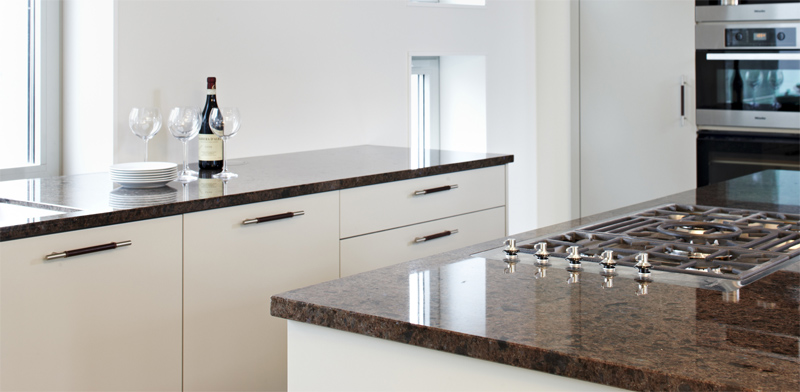Miguel Fabregues
vime@vime.com
This article follows on from our first one about choosing a granite counter-top. Here we publish another opinion on this issue- there are obviously similarities in criteria, but there can also be different sensibilities. Read on.
Would you like to put a granite counter-top in the kitchen?
One assumes the answer is “Yes”.
Is the floor of the kitchen already installed?
If the answer to this question is in the affirmative, then you need to choose the furniture that is compatible with the flooring of the kitchen. Therefore, first decide on the furniture.
But if the answer is “no”, then you first need to choose the flooring of the kitchen. For the floor it is not necessary that it be of one material or of one colour. But first choose what you like the most to be placed in the areas which are not “conflictive”.
What is a not “conflictive” area?
It is one where there are no problems of grease stains, or where there is a lot of transit or problems due to the customary use in the preparation of food. Choose a floor material capable of resisting the effects of aggressive materials, that which resists oils, acids, detergents, etc.
For example, you can choose “cream” materials, granite, marble or ceramic, for these areas which are not “conflictive” and combine them with highly resistant materials in the front of the kitchen, where there is heat, with brown or other tones that look pleasant in the combination and which do not show small spots.
We could recommend more than 50 types of granites that can be combined with all the colours you could want and which, moreover, do not give problems in wearing out nor in the absorption of spots.
It is enough to have the right advisor who indicates which material we should install.
Second, you need to combine the countertop with the flooring: there are, literally, thousands of varieties of granite in the world that can satisfy the aesthetic combination to your taste.

Granite kitchen top by Lundhs
CRITERIAS FOR SELECTION OF KITCHEN COUNTERTOPS
1 It should have utility: the first thing you need is to look for stones which do not give problems such as, for example, when putting on top of it the pressure cooker, or any other hot plate or which contains coffee, fat, wine, lemon, etc.
2 The countertop should resist the aggression of steel, which is the stronger material. We should be able to cut the food without having to place between them and the knife a special support for the cutting.
3 Although it seems to be a lie, granite and all its varieties that, commercially, come under the same name, have more than 50 varieties, which, without any doubt, can fulfil your aesthetic criteria and the physical criteria previously described.
The choice of the right material for each space of the kitchen guarantees you it will be long lasting, exactly the same as on the first day when it was installed.
You ought to consider that, moreover, more than 50 varieties fulfil your needs and have physical and chemical properties that can maintain your kitchens as if they were new.
You should also consider that the illumination in your kitchen, using clear materials or those reflecting in kitchens with poor light and dark materials and honed finish where the illumination is poor.
Therefore, choosing the right material is the first step in obtaining a great and kitchen, unique and without problems, i.e. a natural material is NEVER repeated, this kitchen will be unique.
If you decide to choose other materials that, aesthetically, fulfil your demands better because they fit with the decoration of the bathroom or kitchen, there are other solutions of applications later on which can maintain your stone, unique in the world, in the same conditions as when installed.
1. There are hundreds of stone treatment products in the market which do not let floor or kitchentop be affected by humidity and which prevent stains.
2. Some of these products are certified, such as anti-bacteria, valid for contact with food. This means that they do not allow colonies of bacteria on their surface or areas such as bathrooms or dishwashers.
3. It is very important that the installer of the kitchen be aware which areas are the most delicate for maintenance and protects them so that no problems come up in the future ( edges, gaps, cuts, etc.) These areas need to be treated on the surface and to at least 10 cm depths in the lower part. These parts are not visible, but they absorb and can create problems months after the kitchen has been installed, perhaps due to the absorption of fats-areas of fire- or due to the absorption of humidity-areas of sinks, etc.

Moreover, a kitchen does not simply mean a countertop, it also implies the points where the area of cooking meets that of cleaning. Do not think that a ceramic or paint will clear you of these problems: ceramic also has absorption, paint tends to deteriorate and it is not a resistant material.
It is necessary that the kitchen joints, above all, the areas of fire and cleaning be as resistant as the countertop.
The best advice we can give is-
Would you like to have a unique countertop? Then choose a kitchen with natural stone!
Would you like to have a kitchentop that does not give any problems ? Choose a countertop of granite and choose an appropriate one for your needs !
There are more than 50 varieties, you can be sure, which will satisfy the aesthetic needs and will not give problem for centuries.
But since you do not want any solutions for the next few centuries and, moreover, want to choose a unique product and which is “ideal” for you, there are around 2500 varieties which will give you something exclusive and which, when well treated, are beyond comparison to any artificial material.
